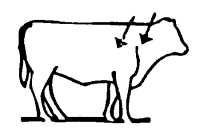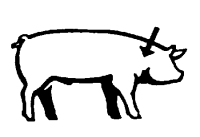Dectomax Injectable Solution (Canada)
This page contains information on Dectomax Injectable Solution for veterinary use.The information provided typically includes the following:
- Dectomax Injectable Solution Indications
- Warnings and cautions for Dectomax Injectable Solution
- Direction and dosage information for Dectomax Injectable Solution
Dectomax Injectable Solution
This treatment applies to the following species:doramectin injectable solution
Veterinary Use Only
sterile
broad-spectrum parasiticide
for cattle and swine
DIN 02231083
Description
Dectomax® injectable solution is a ready-to-use, colourless to pale yellow sterile solution containing 1% w/v doramectin (10 mg/mL) as the medicinal ingredient.
CHARACTERISTICS: Dectomax injectable solution is a highly active, broad- spectrum parasiticide for parenteral administration to cattle and swine. It contains doramectin, a novel fermentation-derived avermectin discovered by Pfizer. Doramectin is isolated from fermentations of selected strains derived from the soil organism Streptomyces avermitilis.
A primary mode of action of avermectins is to modulate chloride ion channel activity in the nervous system of nematode (internal) and arthropod (external) parasites. Avermectins bind to receptors that increase membrane permeability to chloride ions. This inhibits the electrical activity of nerve cells in nematodes and muscle cells in arthropods and causes paralysis and death of the parasites. In mammals, the neuronal receptors to which avermectins bind are localized within the central nervous system (CNS), a site reached by only negligible concentrations of doramectin.
One low-volume dose of Dectomax injectable solution is effective against a wide range of roundworm and arthropod parasites that impair the health and productivity of cattle and swine.
Dectomax injectable solution has a wide margin of safety in all classes of cattle and swine. Its broad spectrum of activity, exceptional toleration, and excellent syringeability make it an excellent product for application as an antiparasitic for cattle and swine.
Dectomax Injectable Solution Indications
Cattle: Dectomax injectable solution is indicated for the treatment of parasitic infections and infestations due to the following species of gastrointestinal roundworms, lungworms, eyeworms, grubs, sucking lice, and psoroptic and sarcoptic mange mites:
Gastrointestinal Roundworms
Ostertagia ostertagi (adults, L4 and inhibited L4)
O. lyrata (adults only)
Haemonchus placei (adults and L4)
Trichostrongylus axei (adults and L4)
T. colubriformis (adults and L4)
Cooperia oncophora (adults and L4)
C. pectinata (adults only)
C. punctata (adults and L4)
C. surnabada (syn. mcmasteri) (adults and L4)
Nematodirus spathiger (adults only)
Bunostomum phlebotomum (adults only)
Strongyloides papillosus (adults only)
Oesophagostomum radiatum (adults and L4)
Trichuris ovis (adults only)
Lungworms
Dictyocaulus viviparus (adults and L4)
Eyeworms
Thelazia spp (adults only)
Grubs (migrating larvae)
Hypoderma bovis
H. lineatum
Sucking Lice
Haematopinus eurysternus
Linognathus vituli
Solenopotes capillatus
Mange Mites
Psoroptes bovis
Sarcoptes scabiei var. bovis
Dectomax injectable solution protects cattle against infection or reinfection with Ostertagia ostertagi and Cooperia punctata for at least 21 days and with Dictyocaulus viviparus for at least 28 days.
Swine: Dectomax injectable solution is indicated for the treatment of parasitic infections and infestations due to the following species of gastrointestinal roundworms, lungworms, kidney worms, sucking lice and sarcoptic mange mites:
Gastrointestinal Roundworms
Ascaris suum (adults and L4)
Oesophagostomum dentatum (adults and L4)
Oesophagostomum quadrispinulatum (adults and L4)
Strongyloides ransomi (adults only)
Hyostrongylus rubidus (adults and L4)
Lungworms
Metastrongylus spp. (adults only)
Kidney Worms
Stephanurus dentatus (adults only)
Sarcoptic Mange Mites
Sarcoptes scabiei var. suis
Sucking Lice
Haematopinus suis
For effective mange eradication, care must be taken to prevent re-infestation from exposure to untreated animals or contaminated facilities.
Dosage and Administration
Cattle: Administer Dectomax injectable solution at a dosage of 200 mcg of doramectin per kg body weight. Each mL contains 10 mg of doramectin, sufficient to treat 50 kg of body weight.
Swine: Administer Dectomax injectable solution at a dosage of 300 mcg of doramectin per kg body weight. Each mL contains 10 mg of doramectin, sufficient to treat 34 kg of body weight.
Dry sterile equipment and aseptic procedures should be used when withdrawing and administering Dectomax injectable solution. The injection site should be cleaned and disinfected with alcohol before injection. The rubber stopper should also be disinfected with alcohol to prevent contamination of contents. For multiple treatments, either automatic injection equipment or an aspirating needle should be used. When the temperature of the formulation is below 5°C, the viscosity of the product increases and increased effort may be required for injecting.
Syringeability may be improved by gently warming the injecting equipment and the product up to 15°C. Animals should be restrained to ensure that treatment can be properly administered.
Cattle: Administer Dectomax injectable solution by the subcutaneous or intramuscular route. Each injection should be made using a clean, dry 16 to 18-gauge needle. Subcutaneous injections should be administered into the neck region using needles 1/2 to 5/8” in length. Intramuscular injections should be administered into a region of large muscle mass (preferably in the lateral neck region) using a 1 1/2” needle. Not more than 10 mL should be injected at any one site.

Swine: Administer Dectomax injectable solution by the intramuscular route into the neck region using an 18 to 20-gauge needle 1/2 to 5/8” in length for young animals, and a 16 to 18-gauge needle 1 to 1-1/2” in length for sows and boars.

Recommended Treatment Program: To effectively initiate control of mange and lice, it is important to treat all animals in the categories below. After initial treatment, use Dectomax injectable solution regularly as follows:
Breeding Animals:
Sows: Treat 7 to 14 days prior to farrowing to minimize exposure of piglets to mites and lice.
Gilts: Treat 7 to 14 days prior to breeding. Treat 7 to 14 days prior to farrowing.
Boars: Treat a minimum of 2 times per year.
Feeder Pigs: Treat any new feeder pigs upon arrival at farm or before placement in clean quarters.
Weaners, Growers, Finishers: Weaner and grower/finisher pigs should be treated before placement in clean quarters.
CAUTIONS: Destruction of Hypoderma larvae (cattle grubs) during the period when these grubs are in vital areas may cause undesirable host-parasite reactions including the possibility of fatalities. Killing Hypoderma lineatum when it is in the tissues surrounding the oesophagus may cause bloat. Killing H. bovis when it is in the vertebral canal may cause staggering or paralysis. These reactions are not specific to treatment with Dectomax injectable solution, but can occur with any successful treatment of grubs. Cattle should be treated either before or after the migratory phase of grub development. Consult your veterinarian concerning the proper time for treatment.
Note:
Underdosing and/or subtherapeutic concentrations of anthelmintic products may encourage the development of parasite resistance. It is recommended that resistance to internal parasites be monitored following the use of any anthelmintic with the use of a Fecal Egg Count Reduction Test (FECRT) program.
There are several measures that can be implemented to help mitigate the risk of resistance, including:
- Anthelmintics should be used in the framework of an integrated parasite control program that should also include measures such as grazing management.
- Avoid indiscriminate use of anthelmintics.
- Carefully follow the instructions given in the section DOSAGE AND ADMINISTRATION. Weigh or estimate the weight of animals as accurately as possible in order to avoid underdosing. Dosing equipment/syringes should be checked regularly for proper calibration.
- Monitor the herd parasite status using methods such as Fecal Egg Count (FEC). Consult your veterinarian for the diagnosis, treatment, and control of parasitism.
Warnings
(1) Treated animals must not be slaughtered for use as food for at least 40 days for cattle and 62 days for swine after the latest treatment with this drug. (2) This product must not be used in lactating dairy cows. (3) Because a withdrawal time for milk has not been established, non-lactating dairy cows must not be treated within 2 months of calving. Keep out of reach of children.Adverse Reactions
Cattle: Injection site reactions and allergic/anaphylactic-type reactions have been reported very rarely after the administration of this product.
Swine: Neurological reactions and allergic/anaphylactic-type reactions have been reported very rarely after the administration of this product.
ENVIRONMENTAL SAFETY: Studies indicate that when doramectin comes in contact with the soil, it readily and tightly binds to the soil and becomes inactive over time. Free doramectin may adversely affect fish or certain water-borne organisms on which they feed. Do not contaminate water by direct application or by the improper disposal of drug containers. Dispose of containers in an approved landfill, or by incineration.
Storage
Store between 15 and 30°C. Use within 90 days of first puncture.PRESENTATION: Dectomax injectable solution is available in 500 mL multi-dose glass vials.
Zoetis® and Dectomax are registered trademarks of Zoetis or its licensors.
Zoetis Canada Inc., Kirkland QC H9H 4M7
|
Net |
|
|
500 mL |
10022825-09-0 |
CPN: 1198033.8
16,740 TRANS-CANADA HIGHWAY, KIRKLAND, QC, H9H 4M7
| Order Desk: | 800-663-8888 | |
| Technical Services Canada: | 800-461-0917 | |
| Technical Services USA: | 800-366-5288 | |
| Website: | www.zoetis.ca |
 |
THIS SERVICE AND DATA ARE PROVIDED "AS IS". Animalytix assumes no liability, and each user assumes full risk, responsibility, and liability, related to its use of the Animalytix service and data. See the Terms of Use for further details. |
Copyright © 2024 Animalytix LLC. Updated: 2024-02-27
